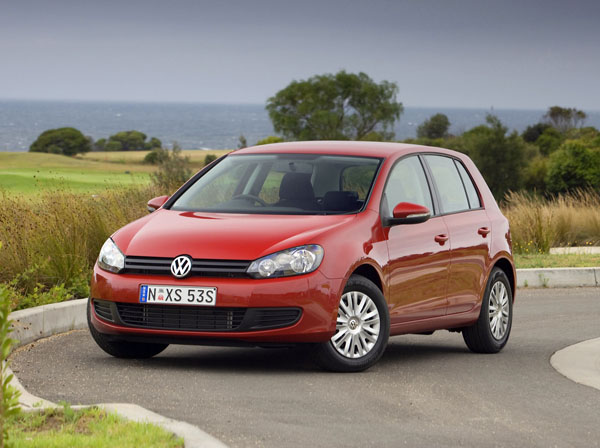Still regarded as a benchmark car in its class if you’re a keen driver, the Volkswagen Golf has had its ups and downs in recent years. Once famed for German build quality and long-term reliability it has experienced more than its fair share of problems in recent years. However, things now appear to be on the straight and narrow again and Golf’s reputation has gone pretty well back to normal.
Golf 6 was a heavily revised version of the Golf 5, with better aerodynamics, a quieter ride and lower fuel consumption and emissions than its predecessor. Definitely the one to aim for if it’s within your budget.
Golf Mk7 was virtually all new. Built on the company’s then new MQB platform it’s about 100kg lighter (depending on model) than the Mk6. It’s a little larger and has improved interior room. It got a significant facelift at the end of 2016 that gave it an ‘aero’ look that was a little further upmarket.
The great majority of Golfs in Australia are five-door door hatchbacks, there are also three-door hatches, five-door station wagons and cabriolets.
Boot space in the sedans is substantially better than in the hatches and Jetta because of its longer tail.
Golf Cabriolet was initially replaced by the New Beetle Cabriolet, but in a surprise move, VW Australia reintroduced the open top Golf in 2012.
Four-cylinder turbo-petrol engines are the most common, though there are plenty of turbo-diesel units in Australia these days as VW has been prompting these here for quite a few years.
Most transmissions in this country are dual-clutch automatics, with six speeds beside the diesels and seven when mated to petrols. The VW group was in the vanguard of this automated-manual type (calling them DSGs). The early units were on the painful side at very slow speeds, later ones are better, but could still do with improvement.
Six-speed manuals are less popular Downunder than in Europe. But may we suggest you at least give one a try if you’re a keen driver.
Those who enjoy a really good drive should consider the VW Golf GTi. A fun machine for the keen driver, it’s showing signs of becoming a minor classic in the Australian hot-hatch market.
These VW is a relatively easy car to work on, spare parts are not overly expensive and we haven’t heard of many complaints about bits being out of stock in major dealerships. Those that are can usually be shipped out within a couple of business days.
The dealer network is extensive, though as usual, they tend to be concentrated in metro areas. Quite a few non-factory mechanics in Australia began their careers working in offical outlets and are often praised by Volkswagen owners who have used them.
Insurance charges are about average for an imported European cars in this class. The high-performance Golf models may attract significantly higher premiums especially if you’re young and/or inexperienced and have a poor insurance record.
WHAT TO LOOK FOR
Some Golf diesel engines from 2008 to 2015 were the subject of a voluntary recall to modify them following the so-called ‘Dieselgate’ emissions scandal. If the work has been done a label will be attached inside the left front door frame. You can contact Volkswagen on 1800 504 076 between 8:30am and 7:00pm Monday to Friday (AEST) to check.
Some DSG automatics in the Golf 6 had serious problems resulting in a voluntary recall by VW Australia. In some cases the complete unit had to be replaced, in others they were repaired. Golf 7 units appear to be much better. Have a qualified mechanic drive the car if there’s the slightest doubt.
Make sure a manual gearbox doesn’t crunch on fast downchanges. This is more likely to have been caused by hard and/or bad driving technique than a defect in the box.
Check the engine oil for darkening, and make sure the sump is full to the correct mark. Low engine oil, and they do seem to use more than their fair share at times, can cause a catastrophic failure.
Engines should start quickly. Listen for untoward noises when it’s cold.
Look for smoke from the exhaust when the engine is driven hard, particularly on long uphill runs.
Check all electric components are working correctly and that no warning lights appear during your test drive.
Feel and look for uneven tyre wear, particularly on the front wheels. This may mean the wheel has been crashed into a kerb, or that the car has been thrashed.
HOW MUCH?
Budget on spending from $4000 to $7000 for a 2009 1.9 TDI; $7000 to $11,000 for 2011 TDI Comfortline or a 2009 GTi; $8000 to $12,000 for a 2012 118TSI Comfortline; $11,000 to $16,000 for a 2012 GTi; $12,000 to $17,000 for a 2013 118TSI or a 2015 92 TSI Trendline; $15,000 to $21,000 for a 2012 R; $17,000 to $24,000 for a 2014 GTi; $21,000 to $29,000 for a 2015 GTi; and $23,000 to $31,000 for a 2017 GTi.
CAR BUYING TIP
The more popular the car the more there are on the used scene. Use this to your advantage by shopping around for the best of them.
RECALLS: To browse recalls on all vehicles go to the ACCC at: www.productsafety.gov.au/products/transport/cars/
